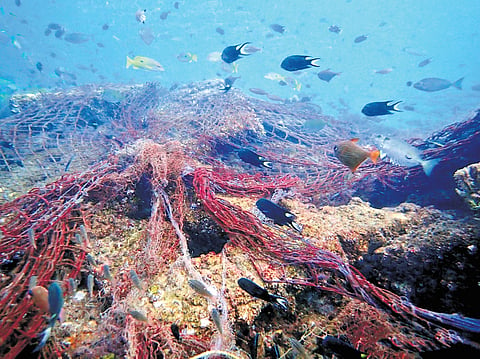

CHENNAI: The fish you eat and the water you drink may contain high concentration of harmful microplastics, the tiny plastic particles which are less than 5 mm in diameter, as per the latest state government-funded research conducted by Thoothukudi-based Suganthi Devadason Marine Research Institute (SDMRI).
The three-year comprehensive study report, which runs into 500 pages, titled ‘Assessment of microplastics in coastal areas, estuaries and lakes in Tamil Nadu’, was released during the TN Climate Summit that was held recently. The results are startling and based on polymer type and shape, it was established that the biggest contributor is the single-use plastics, which are already banned in the state.
For the study, water, sediment, fish and shellfish samples were collected from 112 locations in 18 districts across the state - 51 coastal locations in 14 coastal districts, 19 estuaries and 42 lakes including the ones frequented by tourists such as Kodaikanal, Ooty and Yercaud.
The results show there is not even a single waterbody that was free from microplastics. The finfish and shellfish, which are consumed widely, are ingesting them mistaking it as food. In coastal waters, microplastics abundance ranges between 23 to 155 items per litre (water) and 37 to 189 items per kg (sediment). In estuaries, it ranges from 31 to 154 items per litre and 51 to 171 items per kg. Among the 39 rural and urban lakes studied, urban lakes have higher abundance of microplastics.
Exposure to microplastics
In Tamil Nadu, an average consumer takes 9.83 kg of fish per year, according to the fisheries department. At this rate, people living in the west coast consume 709 items of microplastics, 830 items (Gulf of Mannar), 792 items (Palk Bay) and 1076 items (Coromandel Coast).
Coastal shellfish consumers unknowingly take as many as 1,981 items (West Coast), 1,238 items (Gulf of Mannar), 1,517 items (Palk Bay) and 3,017 items (Coromandel Coast) per year via shellfish consumption. In estuaries, people consume 781 items of microplastics per year via fish and 2,809 items/year via shellfish consumption. Its concentration in shellfish is higher than in fin fish since shell fish are eaten whole. Consumers of shell fish are under greater threat, the report said.
When contacted, Additional Chief Secretary, Environment, Climate Change and Forest Department, Supriya Sahu, told TNIE: “The report confirms what we feared. We have to get rid of the single-use plastics. On one hand, the Meendum Manjappai campaign, is bringing in behavioral changes, and on the other, we are pushing hard to implement the Extended Producers Responsibility (EPR). Data show only 10% of plastic produced is recycled and the remaining 90% is either unscientifically disposed of or end up in dumpsites. Only EPR can ensure the plastics that are produced are taken back. So far, 70 companies have registered with us for compliance, and in the next two months, we will bring all other companies on board. We engaged specialised EPR consultants for the job.”
Hotspots
For comparison and benefit of policy makers, the study divided the coast into four sections - Coromandel coast, Palk Bay, Gulf of Mannar coast and west coast. The results show the hotspot for the microplastics was the Coromandel coast. The highest abundance was found in Kovalam near Chennai.
Even among estuaries, surface water in Adyar estuary in Chennai carries the highest abundance of microplastics in the range of 124 to 154 items per litre and its sediment has 147 to 171 items per kg during both summer and monsoon seasons.
When it comes to lakes, again Chennai’s Chembarambakkam lake has the highest concentration and among tourist lakes, Ooty tops the list followed by Kodaikanal and Yercaud.
SDMRI Director JK Patterson Edward, who is a co-author of the report, told TNIE, “It’s understandable that water samples collected on Coromandel stretch exhibited high concentration of microplastics. The rivers, example Chennai rivers, carry loads of plastic waste from urban spaces into the estuaries and then to sea. Most of the development is also here.”
M Jayanthi, chairperson, Tamil Nadu Pollution Control Board (TNPCB), also a co-author, said, “This is the first-of-its-kind study. As a follow-up, 47 lakes in western and eastern districts were selected for phase-2 study of microplastics. Next, northern and southern district lakes will be studied. Four rivers - Thamirabarani, Vaigai, Vellar and Palar - are also being studied. This will help us identify the problematic areas and take management interventions.”